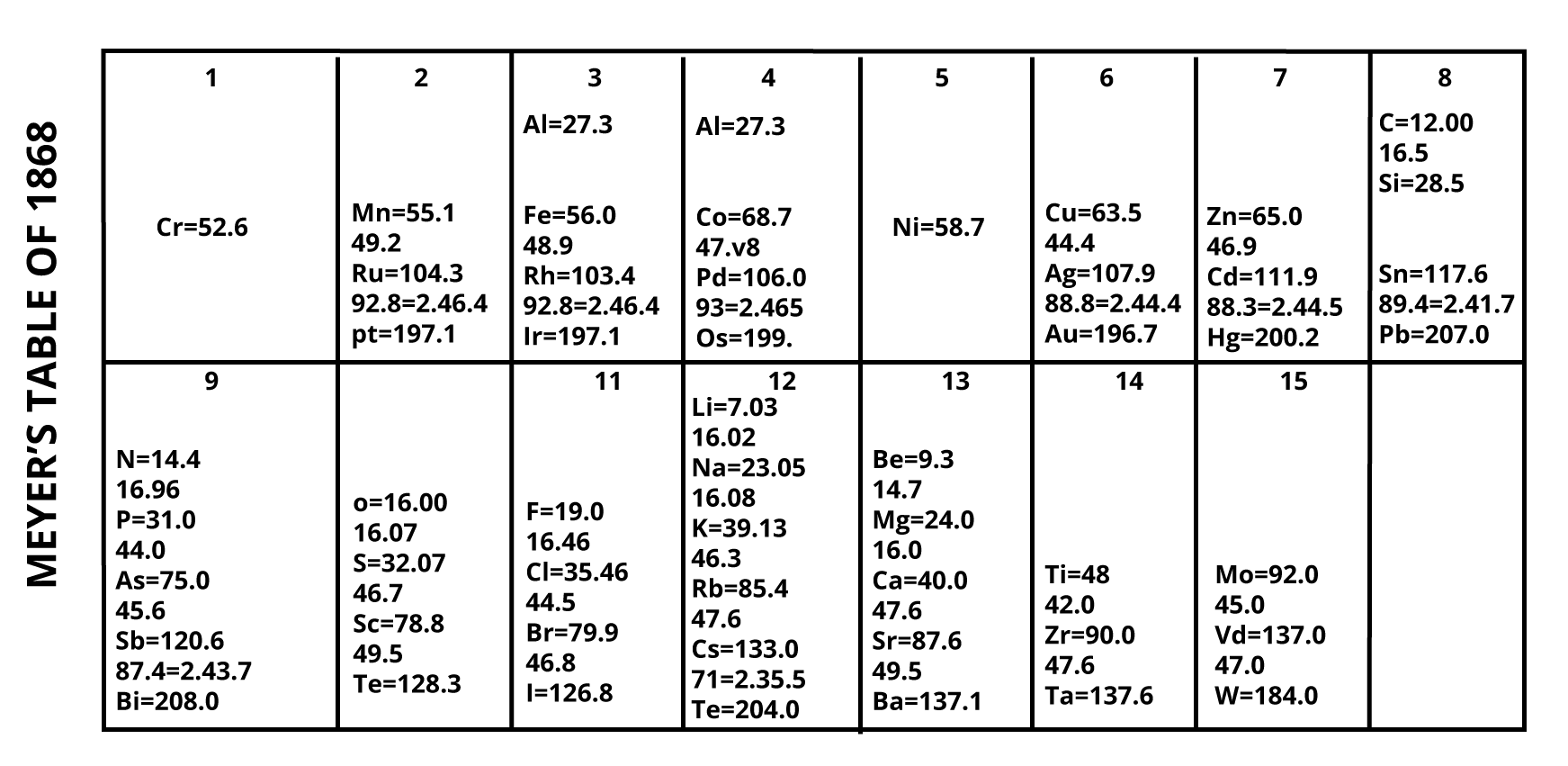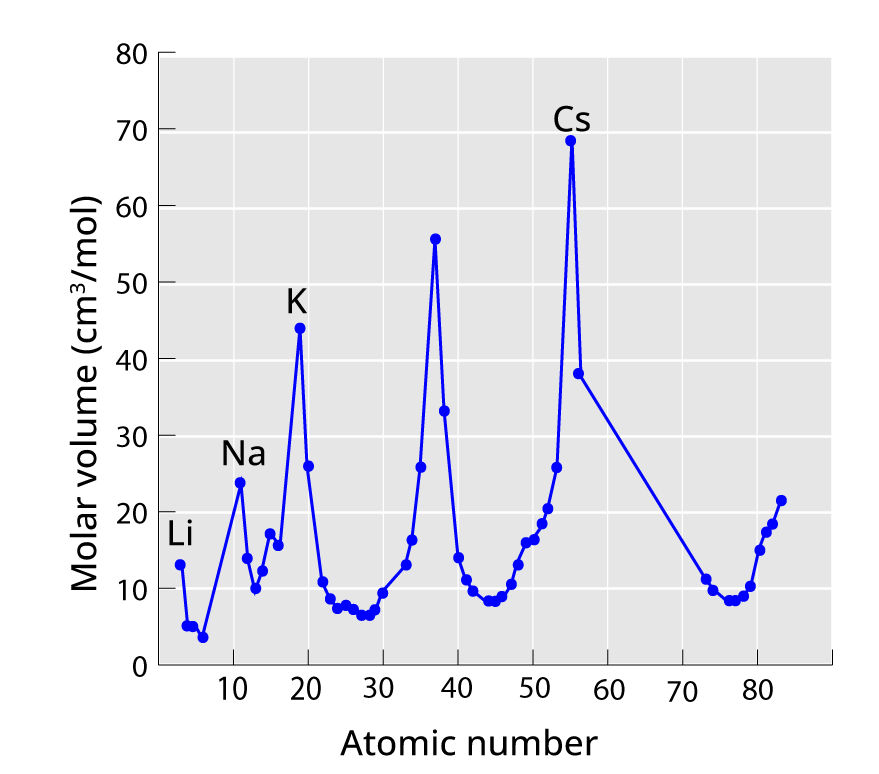




Development of Periodic Table
One of the greatest discoveries in human history, the periodic table, is magnificent in the art of Chemistry. Different chemical element arrangements in different shaped periodic tables serve different purposes. Various chemists have observed qualitative similarities in static and reactive properties among "groups" of elements, since the early nineteenth century, as well as some quantitative relationships between the atomic equivalent masses known as the triad and octave rules.
Furthermore, several scholars discovered in the 1860s that basic properties showed pronounced variations along with the array of atomic masses(A) in a pseudo-periodic manner. This is true for the typical and extremal valence and oxidation numbers, which were independently chosen as the main criteria for grouping the elements by German Lothar Meyer, English John Newlands, and Russian D. Mendeleev in 1864 and 1869, respectively.
Lothar Meyer Periodic Table
Julius Lothar Meyer was born in Heilbron, Germany, and rose to prominence as one of the most influential chemists of his time. In most accounts, he is remembered for his independent discovery of the periodic table, though his contributions are overshadowed by those of the more illustrious Russian, Dimitri Mendeleev. However, in terms of mature periodic systems, Lothar Meyer was the first to publish.
Lothar Meyer published his first periodic table, which included 28 elements, in 1862. He published a textbook in 1864 that included an updated periodic table with 50 elements. Meyer's table appears to be more consistent and accurate than Mendeleev's, including the correct placement of mercury with cadmium, tin with lea and thallium with boron, which Mendeleev did not perform.

Lothar Meyer Periodic Table Published in 1895
Lothar Meyer Classification
Lother Meyer proposed a table from physical properties such as atomic volume, melting point, and so on. He demonstrated that when the properties of the elements, such as atomic volume, melting point, boiling point, and so on, were plotted as a function of their atomic weights, elements with similar properties occupied nearly identical positions.
Physical properties such as atomic volume, melting point, boiling point, and so on were used by Lother Meyer to create his element table. When the properties of the elements, such as atomic volume, melting point, and boiling point, were plotted as a function of their atomic weights, he demonstrated that elements with identical properties occupied nearly identical positions.
All of these attempts yielded the same result. There are certain regularities among the elements. Dmitri Mendeleev, a Russian chemist, made the first successful attempt at element classification.
Lothar Meyer Atomic Volume Curve
Lothar Meyer linked elements' physical properties to their atomic volumes.
The Lothar Meyer graph is drawn by relating the atomic volume to the atomic masses.
Alkaline Earth metals that are relatively less rich, such as Be, Mg, Ca, Sr, Ba, and so on, are located in the descending portion of the curve.
The ascending part of the curve is occupied by halogens and noble gases (aside from helium).
Since alkali metals have the highest volume, they were found at the top of the curve. They are extremely electronegative elements.

Lothar Meyer's Curve
Curve Characteristics
The maxima of the curve is occupied by alkali metals with the largest atomic volumes.
Alkaline earth metals are found near the midpoints of the curve's descent.
Halogens are found in ascending portions of the curve before inert gases.
The transition metals occupy the curve's minima.
Drawbacks of Lother Meyer’s Classification
Meyer's periodic table was insufficient in comparison to Mendeleev's periodic table, which was published the same year and made remarkable predictions about the discovery of certain elements.
Meyer's classification was supported by a study of various physical properties related to atomic weights with no empirical or logical basis or classification, and such values are difficult to remember. Mendeleev's periodic classification, on the other hand, was founded on Periodic Law.
Conclusion
Lothar Meyer proposed the periodic law after studying the physical properties of elements, which states that "when elements are arranged in increasing order of their atomic weights, similarities in physical and chemical properties appear at regular intervals, or the physical properties of the elements are the periodic function of their atomic weights”. Lothar Meyer's atomic volume curve is the graph between the atomic volume of an element to the atomic masses of the element where the alkali metals occupy the maxima of the curve.






FAQs on Lothar Meyer Curve - Important Concepts with Drawbacks for JEE
1. What contribution did Mendeleev make to Chemistry?
Mendeleev developed the first periodic table, which was quickly followed by Meyer. He arranged the elements by mass and proposed that certain properties reoccur on a regular basis. Elements were arranged according to their fundamental property, atomic mass, and chemical characteristics in Mendeleev's periodic table. Mendeleev discovered a periodic relationship between the properties of elements and atomic mass after researching the characteristics of each element. Elements with comparable properties fall into the same vertical columns of the periodic table. Mendeleev's table is notable because it contains blank spaces for unknown elements as well as the most accurate atomic mass values.
2. How did Meyer arrange the periodic table?
Meyer took into account the volume occupied by fixed weights of the various elements. Each weight had the same number of atoms of the same element (Avogadro's number). This meant that the ratio of the volumes of the various elements was equal to the ratio of the volumes of the various elements' single atoms. Lothar Meyer was thus able to calculate the atomic volumes of elements. When the atomic volumes of the elements were plotted against their atomic weight, they produced a series of peaks. A number of physical properties other than atomic volume fell and rose during each period.























